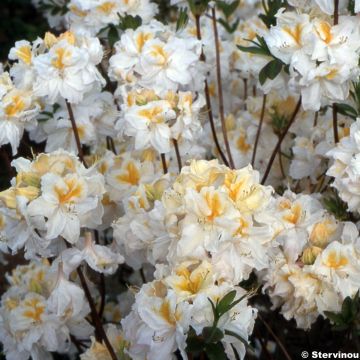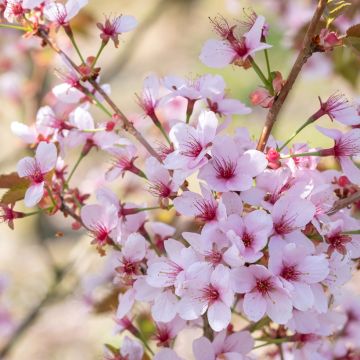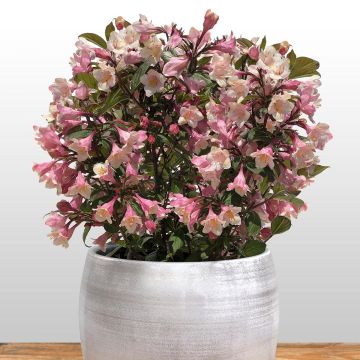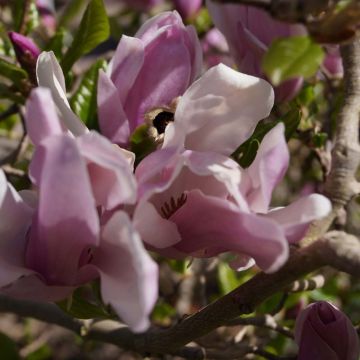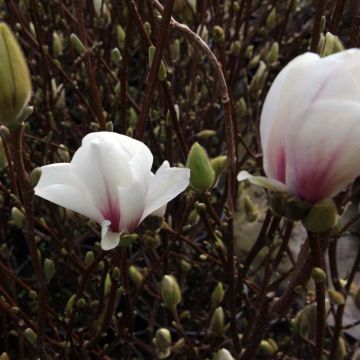

Rhododendron austrinum
Rhododendron austrinum
Rhododendron (Azalea) austrinum
This item cannot be shipped to the selected country
Delivery charge from €5.90
More information
Schedule delivery date,
and select date in basket
This plant carries a 24 months recovery warranty
More information
We guarantee the quality of our plants for a full growing cycle, and will replace at our expense any plant that fails to recover under normal climatic and planting conditions.
From €5.90 for pickup delivery and €6.90 for home delivery
Express home delivery from €8.90.
Does this plant fit my garden?
Set up your Plantfit profile →
Description
Rhododendron austrinum, also known as the Florida azalea, is a deciduous botanical species that offers a spectacular and fragrant flowering of golden yellow blooms. The bush grows quite large but remains dense. In early or mid-spring, it is covered with large clusters of yellow flowers tinted with red at the base. They bloom at the same time as the leaves appear. The flowers emit a delightful honeysuckle fragrance. This species is also appreciated for its beautiful autumn colours. Originally from Florida, it is perfectly adapted to hot climates and is resistant to drought. However, it does not thrive in cool and rainy summer climates. Plant it in partial shade, near the house or a passageway to enjoy its fragrance. Although hardy, its flowers can be sensitive to spring frosts.
Rhododendrons belong to the Ericaceae family, just like heathers. In most cases, they prefer soils with an acidic tendency, devoid of limestone. They also like moist soils that are rich in humus. Rhododendron austrinum is native to Florida and southern Georgia in the United States. It is characterised by an upright habit. It spreads slowly and reaches an average height of 1.7m (6ft) with a span of 1.4m (5ft) at maturity in our climates, under favourable growing conditions. Flowering takes place in April or May. The foliage unfolds at the same time as clusters of 10 to 24 funnel-shaped flowers with narrow tubes appear at the ends of the branches. Each flower measures 3 to 4cm (1 to 2in) long and 4 to 5cm (2in) in diameter. They emit a powerful fragrance reminiscent of honeysuckle and attract numerous pollinating insects. The brown-coloured branches bear deciduous, elliptical, slightly villous leaves. Their colour varies from spring acid green to deep summer green, before ending in shades of orange, yellow, and bronze in autumn. This bush likes partial shade and moist, humus-bearing, and well-aerated soils with a pH between 4.5 and 6.5.
It is hardy down to -18°C (-0.4°F). It can be planted en masse in borders, in hedges, or grown in large containers. Plant it alongside other acid-loving plants, or with beautiful evergreen shrubs. Consider planting it with strawberry trees, autumn camellias, and Japanese maples with green or purple foliage. It can also be planted as a standalone plant in a small garden. Try to plant it near the house to enjoy its beautiful fragrance.
All parts of the plant are toxic.
Report an error about the product description
Plant habit
Flowering
Foliage
Botanical data
Rhododendron (Azalea)
austrinum
Ericaceae
Azalea austrina
North America
Other Chinese Azalea
Planting and care
Rhododendron austrinum thrives in partial shade and prefers a sheltered location away from strong winds and the scorching afternoon sun. It appreciates well-drained but moist, humus-rich, and fertile soils with a pH between 4.5 and 6.5. Like all plants in the ericaceous family, it cannot tolerate alkaline or lime-rich soils. It also dislikes heavy, permanently wet, and waterlogged soils in winter. Dig a hole three times larger than the pot. Soak the root ball in non-calcareous water and plant the bush at the collar level in a mixture composed of 1/4 peat, leaf compost, gravel or pumice, and good-quality topsoil. Add dried blood and crushed horn at the bottom of the planting hole, but without direct contact with the roots (spread a layer of compost over this fertiliser before installing the plant). Water generously and keep the soil moist in summer.
Azaleas and rhododendrons generally have a shallow root system, making them susceptible to prolonged periods of drought. Therefore, it is recommended to enrich the soil with humus and provide abundant watering during dry periods. However, once established, Rhododendron austrinum shows resistance to drought. Additionally, its root system is not very strong, which is why it is essential to lighten heavy soils with draining materials (gravel, pumice, clay pellets) during planting. Apply a mulch of crushed pine bark around the base of the bush every spring to maintain soil moisture while preserving an acidic pH.
Maintenance involves removing faded flowers in summer and cleaning dead branches.
Azaleas and rhododendrons can sometimes be attacked by weevils, which eat the edges of the leaves and rootlets, as well as the notorious "rhododendron beetle," which rarely causes severe damage. Yellowing of the leaves (chlorosis) in rhododendrons indicates poor assimilation of iron in the soil and can lead to premature plant death. While limestone is often the cause, poorly drained soil or deeply planted root balls can also explain this phenomenon.
The most commonly observed fungal diseases in rhododendrons are phytophthora in warm and humid soil, armillaria, and mildew.
Planting period
Intended location
Care
This item has not been reviewed yet - be the first to leave a review about it.
Spring-flowering shrubs
Haven't found what you were looking for?
Hardiness is the lowest winter temperature a plant can endure without suffering serious damage or even dying. However, hardiness is affected by location (a sheltered area, such as a patio), protection (winter cover) and soil type (hardiness is improved by well-drained soil).

Photo Sharing Terms & Conditions
In order to encourage gardeners to interact and share their experiences, Promesse de fleurs offers various media enabling content to be uploaded onto its Site - in particular via the ‘Photo sharing’ module.
The User agrees to refrain from:
- Posting any content that is illegal, prejudicial, insulting, racist, inciteful to hatred, revisionist, contrary to public decency, that infringes on privacy or on the privacy rights of third parties, in particular the publicity rights of persons and goods, intellectual property rights, or the right to privacy.
- Submitting content on behalf of a third party;
- Impersonate the identity of a third party and/or publish any personal information about a third party;
In general, the User undertakes to refrain from any unethical behaviour.
All Content (in particular text, comments, files, images, photos, videos, creative works, etc.), which may be subject to property or intellectual property rights, image or other private rights, shall remain the property of the User, subject to the limited rights granted by the terms of the licence granted by Promesse de fleurs as stated below. Users are at liberty to publish or not to publish such Content on the Site, notably via the ‘Photo Sharing’ facility, and accept that this Content shall be made public and freely accessible, notably on the Internet.
Users further acknowledge, undertake to have ,and guarantee that they hold all necessary rights and permissions to publish such material on the Site, in particular with regard to the legislation in force pertaining to any privacy, property, intellectual property, image, or contractual rights, or rights of any other nature. By publishing such Content on the Site, Users acknowledge accepting full liability as publishers of the Content within the meaning of the law, and grant Promesse de fleurs, free of charge, an inclusive, worldwide licence for the said Content for the entire duration of its publication, including all reproduction, representation, up/downloading, displaying, performing, transmission, and storage rights.
Users also grant permission for their name to be linked to the Content and accept that this link may not always be made available.
By engaging in posting material, Users consent to their Content becoming automatically accessible on the Internet, in particular on other sites and/or blogs and/or web pages of the Promesse de fleurs site, including in particular social pages and the Promesse de fleurs catalogue.
Users may secure the removal of entrusted content free of charge by issuing a simple request via our contact form.
The flowering period indicated on our website applies to countries and regions located in USDA zone 8 (France, the United Kingdom, Ireland, the Netherlands, etc.)
It will vary according to where you live:
- In zones 9 to 10 (Italy, Spain, Greece, etc.), flowering will occur about 2 to 4 weeks earlier.
- In zones 6 to 7 (Germany, Poland, Slovenia, and lower mountainous regions), flowering will be delayed by 2 to 3 weeks.
- In zone 5 (Central Europe, Scandinavia), blooming will be delayed by 3 to 5 weeks.
In temperate climates, pruning of spring-flowering shrubs (forsythia, spireas, etc.) should be done just after flowering.
Pruning of summer-flowering shrubs (Indian Lilac, Perovskia, etc.) can be done in winter or spring.
In cold regions as well as with frost-sensitive plants, avoid pruning too early when severe frosts may still occur.
The planting period indicated on our website applies to countries and regions located in USDA zone 8 (France, United Kingdom, Ireland, Netherlands).
It will vary according to where you live:
- In Mediterranean zones (Marseille, Madrid, Milan, etc.), autumn and winter are the best planting periods.
- In continental zones (Strasbourg, Munich, Vienna, etc.), delay planting by 2 to 3 weeks in spring and bring it forward by 2 to 4 weeks in autumn.
- In mountainous regions (the Alps, Pyrenees, Carpathians, etc.), it is best to plant in late spring (May-June) or late summer (August-September).
The harvesting period indicated on our website applies to countries and regions in USDA zone 8 (France, England, Ireland, the Netherlands).
In colder areas (Scandinavia, Poland, Austria...) fruit and vegetable harvests are likely to be delayed by 3-4 weeks.
In warmer areas (Italy, Spain, Greece, etc.), harvesting will probably take place earlier, depending on weather conditions.
The sowing periods indicated on our website apply to countries and regions within USDA Zone 8 (France, UK, Ireland, Netherlands).
In colder areas (Scandinavia, Poland, Austria...), delay any outdoor sowing by 3-4 weeks, or sow under glass.
In warmer climes (Italy, Spain, Greece, etc.), bring outdoor sowing forward by a few weeks.




































